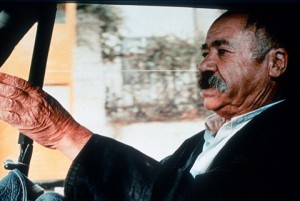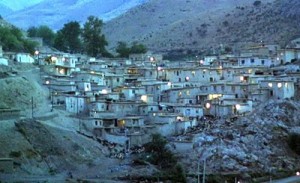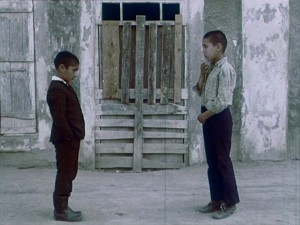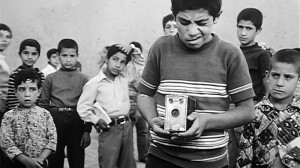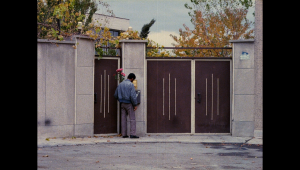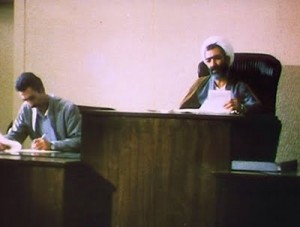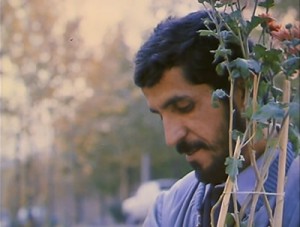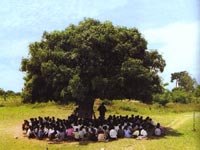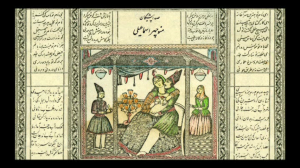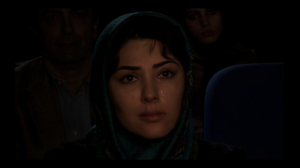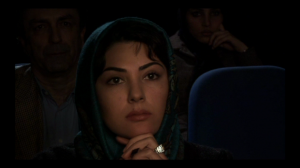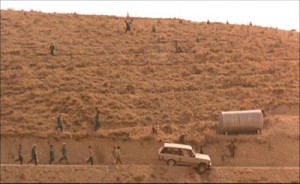This is a slightly different edit of a dialogue proposed and inaugurated by Ehsan Khoshbakht on July 5, 2016, edited by him, and published in the British Council’s online Underline magazine on July 8. — J.R.
Abbas Kiarostami (1940-2016), arguably the greatest of Iranian filmmakers, was a master of interruption and reduction in cinema. He, who passed away on Monday in a Paris hospital, diverted cinema from its course more than once. From his experimental children’s films to deconstructing the meaning of documentary and fiction, to digital experimentation, every move brought him new admirers and cost him some of his old ones. Kiarostami provided a style, a film language, with a valid grammar of its own. On the occasion of this great loss, Jonathan Rosenbaum and I discussed some aspects of Kiarostami’s world. Jonathan, the former chief film critic at Chicago Reader, is the co-author (with Mehrnaz Saeed-Vafa) of a book on Kiarostami, available from the University of Illinois Press. – Ehsan Khoshbakht
Ehsan Khoshbakht: Abbas Kiarostami’s impact on Iranian cinema was so colossal that it almost swallowed up everything before it, and to a certain extent after it. For better or worse, Iranian cinema was equated with Abbas Kiarostami. It was good because it made Iranian cinema a global phenomenon. And not so good when it overshadowed other filmmakers and other existing modes of filmmaking in Iran. Can you think of any other filmmaker whose presence could have dominated a national cinema to such an extent?
Jonathan Rosenbaum: As you know, I tend to view Kiarostami more in transnational terms. In terms of being identified with a national cinema from outside that particular nation, I suppose one could cite Satyajit Ray, Almodovar, Bergman, and Kurosawa, among others. But from a transnational perspective, I suspect that the only figure comparable to Kiarostami, both in terms of influence and in terms of stirring up controversies, would be Godard. Godard himself apparently once said that the cinema that begins with Griffith ends with Kiarostami. For me, both directors excelled in creating global newspapers during separate decades — Godard in the 60s, Kiarostami in the 90s. And people are still quarrelling about their formal procedures in comparable ways. Another parallel with Godard worth mentioning is the capacity of both filmmakers to keep reinventing themselves, in terms of audience, format, relation to narrative, and much else besides. You might even say that Godard and Kiarostami each have had as many “periods” as Picasso did.
EK: “Global newspapers”, let’s talk about that. You’ve definitely read things off screen where many of your colleagues, in Iran and abroad, haven’t. The Cannes review of Taste of Cherry by Roger Ebert remains a classic example when he says “I thought I had seen an emperor without any clothes.” Yet when Ramin Bahrani’s Goodbye Solo, a remake of sorts, appeared some years later, Ebert raved about it and called it one of the greatest American films. How were some people looking at Kiarostami that they couldn’t see the things as you did?
JR: I think this was due to Kiarostami’s rather modernist disbelief in cinema as an institution, complicated and in some ways contradicted by his expertise at playing with cinematic conventions and codes as a master illusionist. The fact that most of the actors in the dialogues of Taste of Cherry never even met is a good illustration of this. Whereas his imitators who aimed at neorealistic narratives never confused or challenged the reflexes of people like Ebert. Those who compared Kiarostami to De Sica or Ray always missed the foundations of his cinema, which only pretended to be narratives in the conventional sense, and were much closer to being agnostic philosophical treatises disguised as stories. Most of Kiarostami’s imitators phrase their films as statements; Kiarostami’s are phrased as questions, explorations and journeys without clearly marked destinations or conclusions. For anyone who relies on the satisfying closures of conventional narratives, this can clearly be maddening.
EK: Of course, comparing Kiarostami to neorealists is one of the key mistakes made by those fascinated by the surface of his cinema. Yet, this is hardly the only misunderstanding. Do you remember last year, after the screening of A Simple Event we had this discussion that calling Kiarostami a disciple of Sohrab Shahid Saless, only because there are children in their films, is a mistake (maybe except for the brief dream sequence of The Traveler). I think the fact that a large fraction of Kiarostami’s cinema was about or with children led to more misunderstandings, as the use of children was considered a) neorealistic, b) political (a la Eastern bloc cinemas). Do you think he was interested in using children because of their vulnerability, or maybe their determination and openness? I still haven’t quite figured out why, when he was equally brilliant in films made with adults (such as Close-Up), he spent so many years on children. It is true that he was a civil servant and working for Kanun was his full-time job. Still, it was Kanun that produced Close-Up as a one-off project.
JR: Children are (perhaps) easier to manipulate, and of course his experience with Kanun got him accustomed to using them. Another possibly relevant factor: starting outside the commercial industry, he became predisposed towards reinventing the cinema in his own way, for his own purposes, and children, by virtue of having fewer preconceptions, may have served as ideal vessels in that venture.
I have a question for you. Adrian Martin in an extended essay on Kiarostami is very caustic and dismissive about ABC Africa, whereas I see it as a minor but honourable recasting of some of the themes (e.g., death) and procedures (e.g., darkness) of the major films preceding it. For me, the worst Kiarostami films are The First Graders and (to a lesser extent) Report, but not so much ABC Africa. What do you think of it?
EK: I can see some good or even great things in ABC Africa (the blackout sequence being one). But in general, I have some issues with the film. Any film with black kids dancing for the camera of a “white” director makes me feel uncomfortable. But I think it’s chiefly because of Kiarostami’s lack of knowledge about the subject and even his reluctance to dig deep. As if in this case his humanism created a safe-guard, a distance between him and the tragedy of the subject. The First Graders is the closest thing to a pro-Islamic Revolution film Kiarostami ever made, confirming the necessity of a Principal in society. I find it interesting because of its political dimensions, even if I don’t agree with them. And I can understand why you don’t like Report. But I welcome it more than I should because of the depiction of the middle class life in Tehran, something very rare in Iranian cinema, maybe except in sleazy filmfarsis with their exaggerated depictions of the class which soon became the driving force of the Revolution. Another film which doesn’t work for me at all is his segment in Tickets.
JR: I’m not so crazy about the Tickets episode either, although my late friend Gil Perez liked it a lot. I agree that Report has many interesting aspects in spite of its artistic failures, and I also view Certified Copy as a successful remake of that film. (I believe that Kiarostami felt that way about it himself.) Your negative point about ABC Africa is well taken, and on the whole I agree with both you and Adrian that it shows the limits of his touristic perspective.
We haven’t discussed Shirin, which in some ways I regard as his most radical film. The limitations in this case, at least for me, is that its achievements are mainly theoretical and technical rather than emotional or philosophical. Like Someone in Love didn’t win me over fully because I thought its view of relationships was rather defeatist and cynical, but I believe one could also say that it resumes Kiarostami’s project as a global journalist telling us a lot about the nature of the contemporary world, certainly more than Certified Copy does (which has plenty of other strengths).
EK: Shirin, in my opinion, is the quintessential late period Kiarostami, maybe because this time he explicitly deals with those themes and cinematic practices with which he was preoccupied since the 1970s. Of course, towards the end, Kiarostami got tired of working with non-professionals and I think Shirin, an all-star film, was a good example of him doing his version of a more “mainstream” cinema. I don’t know if you’ve seen this recently discovered Georges Méliès film, Bouquet d’illusions (1902), in which Méliès, using one of his classic cinematic tricks, juggles the heads of various women, variably puts different heads on different torsos, and eventually beheads himself and puts his head on one female torso. It reminded me of Kiarostami, especially in Shirin with its rare sense of female identification. So maybe Kiarostami is more Méliès than Lumière after all?
***
Postscript: Here is the text I contributed to a privately held Kiarostami event organized by Peter Scarlet in New York on July 15 (with one additional sentence added, about my last encounter with him):
Abbas was a prince — not only because he had enough confidence as an artist to be unworried about whether or not his work was misunderstood, but also because he actually enjoyed some of the misreadings his work received, reasoning that part of the creative work done on his filmmaking was done by the audience, which had a will and an imagination of its own. He was also a prince because of his social elegance, the way he had of listening and responding to others. I treasure him as a friend quite apart from his extraordinary range and craft as a filmmaker (a master illusionist who could beat Hollywood at its own game in spite of his indifference to the cinematic apparatus), and some of the memories of him that I treasure most include going shopping with him in Chicago for CDs by John Coltrane for one of his sons, getting stoned with him on home-grown joints at a party in Tehran, seeing The House is Black for the first time a few rows in front of him in Locarno, and hearing him say jokingly on a panel that we were both on at Stamford University that my objections to his removing the final scene of Taste of Cherry from some of the prints shown in Italy were like the commands of a mullah. The last time I saw him was at a massive retrospective devoted to his work in Torino about a dozen years ago, where I was able to give him a copy of the book about him that I cowrote with Mehrnaz Saeed-Vafa, and he gave me a huge and beautiful Iranian book devoted to some of his landscape photographs that he had carried with him all the way from Tehran. I was also fortunate enough to ride in a car with him down the same roads traveled in Taste of Cherry, and to have seen ABC Africa for the first time, in a rough cut, in his own living room, where I could also observe how much his paintings of landscapes resembled his photographs, especially from a distance. He looked at everything from a distance, but he was anything but cold. I already miss him.


